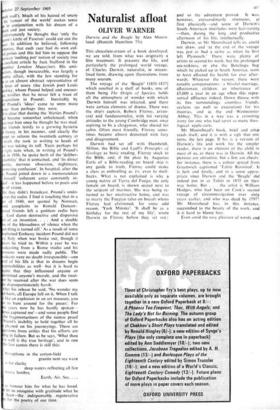Naturalist afloat
OLIVER WARNER
Darwin and the Beagle by Alan Moore- head (Hamish Hamilton 75s) This chocolate-cream of a book developed, we are told, from what was originally a film treatment. It presents the life, and particularly the prolonged world voyage, of Charles Darwin, naturalist, in stream- lined form, drawing upon illustrations trom many sources.
The voyage of the 'Beagle' (1831-1837) which resulted in a shelf of books, one of them being The Origin of Species, holds all the atmosphere of wonder with which Darwin himself was infected, and there were certain elements of drama. There was the ship's captain, Robert Fitzroy, aristo- crat and fundamentalist, with his varying attitudes to the young Cambridge man, once aspiring to be a clergyman, who shared his cabin. Often most friendly, Fitzroy some- times became almost demented with fury and disagreement.
Darwin had set off with Humboldt, Milton, the Bible and Lyell's Principles of Geology as basic reading. Fitzroy stuck to the Bible, and, if the plate by Augustus Earle of a Bible-reading on board ship is any guide to truth, Fitzroy could make a class as enthralling as TV, even to shell- backs. What is not explained is why a young native of Tierra del Fuego, the only female on board, is shown seated next to the serjeant of marines. She was being re- turned to her unattractive home, and was to marry the Fuegian (also on board) whom Fitzroy had christened, for some odd reason, 'York Minster'. 'It shall be as a birthday for the rest of my life', wrote Darwin to Fitzroy before they set out:
and so the adventure proved. It was, however, extraordinarily strenuous, at first physically—and some of Darwin's South American interludes were hair-raising —then, during the long and productive afternoon of his life, intellectually.
Darwin, so Mr Moorehead tells us, could not draw, and 'at the end of the voyage was just as bad a sailor as when he first left Plymouth.' There were plenty of artists to second his work, but the prolonged sea-sickness, or else the Benchuga bug which he picked up in South America, seem to have affected his health for ever after- wards. Whatever the reason, there were notable compensations: a blissful marriage, affectionate children, an inheritance of £5,000 a year in an age when this repre- sented affluence indeed, Down House with its fine surroundings, countless friends, acclaim (as well as execration) for his theories, and at the end—Westminster Abbey. This in a way was a crowning irony for one who had upset so many theo- logical apple-carts.
Mr Moorehead's book, brief and crisp reads itself, and it is with a sigh that one turns the last page. If his is a version of Darwin's life and work for the simpler reader, there is an element of the child in most of us, as there was in Darwin. All the pictures are attractive, but a few are cheats: for instance, there is a colour spread from Greenwich captioned 'Tahiti Revisited'. It is lush and lovely, and in a sense appro- priate since Darwin and the 'Beagle' did indeed put in at Tahiti in 1835 on their way home. But . . . the artist is William Hodges, who had been on Cook's second voyage of circumnavigation over sixty years earlier, and who was dead by 1797! Mr Moorehead has, in this instance, succumbed to the beauty of the work, and it is hard to blame him.
Even amid the easy pleasure of words and
pictures, a phrase or a sentence may give cause for more prolonged thought about this exceptional man. 'It is now ten years since my return', so Darwin wrote to his friend and mentor, Professor J. S.-Henslow of Cambridge, 'and your words, which I thought preposterous, are come true, that it would take twice the number of years to describe, that it took to collect and observe'. Mr Moorehead adds: 'In fact there was one item left over from the voyage, a tiny cirri- pede or barnacle, not much bigger than the head of a pin, and the study and classifica- tion of this species took up the next eight years . . •







































 Previous page
Previous page